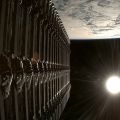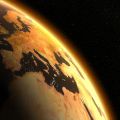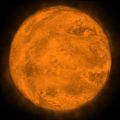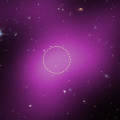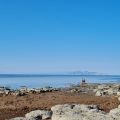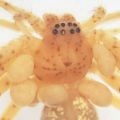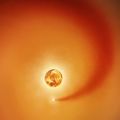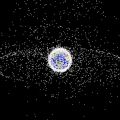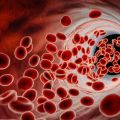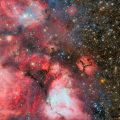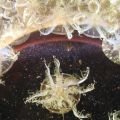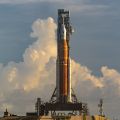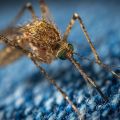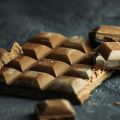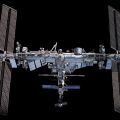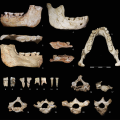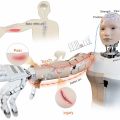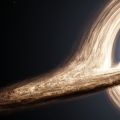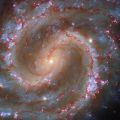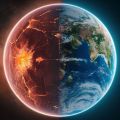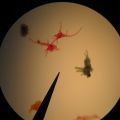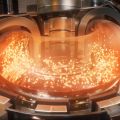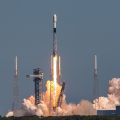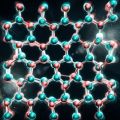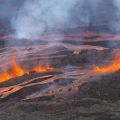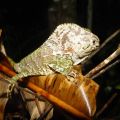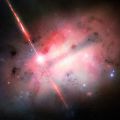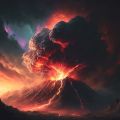Satellites naturels de Saturne - Définition
La liste des auteurs de cet article est disponible ici.
Dénomination
Les noms modernes pour les lunes de Saturne ont été suggérés par John Herschel en 1847 . Il a proposé de leur donner le nom des personnages mythologiques associés au dieu romain de l'agriculture et la récolte, Saturne (assimilé au titan grec Cronos). En particulier, les sept satellites alors connus ont été nommés d'après les Titans et les Titanides. En 1848, Lassell a proposé que le huitième satellite de Saturne soit nommé Hyperion, nom d'un autre Titan. Lorsque les noms des Titans furent épuisés, les lunes ont été nommées d'après les différents personnages de la mythologie gréco-romaine ou des géants d'autres mythologies. Toutes les lunes irrégulières (sauf Phoebe) sont nommées d'après des dieux Inuits et celtiques et d'après les géants de la mythologie nordique.
Liste
Note : Les satellites de Saturne sont classés ici par période orbitale croissante. Les satellites suffisamment massifs pour que leur surface ait formé un sphéroïde sont en gras. Les satellites irréguliers sont en rouge, orange ou gris.
| Key | ||||
|---|---|---|---|---|
| † Satellites majeurs | ♠ Titan | ‡ Groupe Inuit | ♦ Groupe celte | ♣ Groupe nordique |
| Ordre | Label | Nom | Image | Diametre (km) | Masse (1018 kg) | Demi-grand axe (km) | Période orbitale (j) | Inclinaison (°) | Excentricité | Position | Année de découverte | Découvreur |
|---|---|---|---|---|---|---|---|---|---|---|---|---|
| 0 |
| ≈ 0.3 | <0.0000001 | ≈ 117,000 | ≈ 0.47 | ≈ 0° | ≈ 0 | Division de Cassini | 2009 | Cassini–Huygens | ||
| 1 | XVIII | Pan |
| 28.4 ± 2.6 (35×32×21) | 0.00495±0.00075 | 133,584 | +0.57505 | 0.001° | 0.000035 | Division d'Encke | 1990 | M. Showalter |
| 2 | XXXV | Daphnis |
| 7.8 ± 1.6 (9×9×6) | 0.000084±0.000012 | 136,505 | +0.59408 | ≈ 0° | ≈ 0 | Lacune de Keeler | 2005 | Cassini–Huygens |
| 3 | XV | Atlas |

| 30.2 ± 2.8 (42×36×18) | 0.0066 ± 0.00006 | 137,670 | +0.60169 | 0.003° | 0.0012 | Anneau A (berger externe) | 1980 | Voyager 2 |
| 4 | XVI | Prométhée |

| 86.2 ± 5.4 (123×79×61) | 0.1566 ± 0.0019 | 139,380 | +0.61299 | 0.008° | 0.0022 | Anneau F (berger interne) | 1980 | Voyager 2 |
| 5 | XVII | Pandore |
| 80.6 ± 4.4 (103×80×64) | 0.1356 ± 0.0022 | 141,720 | +0.62850 | 0.050° | 0.0042 | Anneau F (berger externe) | 1980 | Voyager 2 |
| 6a | XI | Epimethée |
| 113.4 ± 3.8 (116×117×106) | 0.53040±0.00193 | 151,422 | +0.69433 | 0.335° | 0.0098 | Co-orbital avec Janus | 1977 | J. Fountain, and S. Larson |
| 6b | X | Janus |
| 179.2 ± 4 (195×194×152) | 1.912 ± 0.005 | 151,472 | +0.69466 | 0.165° | 0.0068 | Co-orbital avec Épiméthée | 1966 | A. Dollfus |
| 8 | LIII | Égéon |
| ≈ 0.5 | ~0.0000001 | 167,500 | +0.80812 | 0.001° | 0.0002 | Dans l'anneau G | 2008 | Cassini–Huygens |
| 9 | I | †Mimas |

| 396.4 ± 1.0 (415×394×381) | 37.493 ± 0.031 | 185,404 | +0.942422 | 1.566° | 0.0202 | 1789 | W. Herschel | |
| 10 | XXXII | Methone |
| 3.2 ± 1.2 | ~0.00002 | 194,440 | +1.00957 | 0.007° | 0.0001 | 2004 | Cassini–Huygens | |
| 11 | XLIX | Anthée | ≈ 2 | ~0.000007 | 197,700 | +1.03650 | 0.1° | 0.001 | 2007 | Cassini–Huygens | ||
| 12 | XXXIII | Pallene |
| 4.4 ± 0.6 (5×4×4) | ~0.00005 | 212,280 | +1.15375 | 0.181° | 0.0040 | 2004 | Cassini–Huygens | |
| 13 | II | †Encelade |

| 504.2 ± 0.4 (513×503×497) | 108.022 ± 0.101 | 237,950 | +1.370218 | 0.010° | 0.0047 | Anneau E | 1789 | W. Herschel |
| 14 | III | †Tethys |

| 1,066 ± 2.8 (1081×1062×1055) | 617.049 ± 0.132 | 294,619 | +1.887802 | 0.168° | 0.0001 | 1684 | G. Cassini | |
| 14a | XIII | Telesto |
| 24.8 ± 0.8 (31×24×21) | ~0.00941 | 294,619 | +1.887802 | 1.158° | 0.000 | Point de Lagrange avant de Téthys | 1980 | B. Smith, H. Reitsema, S. Larson, and J. Fountain |
| 14b | XIV | Calypso |
| 21.2 ± 1.4 (30×23×14) | ~0.0063 | 294,619 | +1.887802 | 1.473° | 0.000 | Point de Lagrange arrière de Téthys | 1980 | D. Pascu, P. Seidelmann, W. Baum, and D. Currie |
| 17 | IV | †Dione |

| 1,123.4 ± 1.8 (1128×1122×1121) | 1,095.452 ± 0.168 | 377,396 | +2.736915 | 0.002° | 0.0022 | 1684 | G. Cassini | |
| 17a | XII | Helene |

| 33 ± 1.2 (39×37×25) | ~0.02446 | 377,396 | +2.736915 | 0.212° | 0.0022 | Point de Lagrange avant de Dioné | 1980 | P. Laques and J. Lecacheux |
| 17b | XXXIV | Pollux |
| 2.6 ± 0.8 (3×2×1) | ~0.00003 | 377,396 | +2.736915 | 0.177° | 0.0192 | Point de Lagrange arrière de Dioné | 2004 | Cassini–Huygens |
| 20 | V | †Rhea |
| 1,528.6 ± 4.4 (1534×1525×1526) | 2,306.518 ± 0.353 | 527,108 | +4.518212 | 0.327° | 0.001258 | 1672 | G. Cassini | |
| 21 | VI | ♠Titan |

| 5,151 | 134,520 ± 20 | 1,221,930 | +15.94542 | 0.3485° | 0.0288 | 1655 | C. Huygens | |
| 22 | VII | †Hyperion |

| 266 ± 8 (328×260×214) | 5.584 ± 0.068 | 1,481,010 | +21.27661 | 0.568° | 0.123006 | En résonance orbitale 3:4 avec Titan | 1848 | W. Bond G. Bond W. Lassell |
| 23 | VIII | †Japet | 1,471.2 ± 6.0 (1495×1498×1425) | 1,805.635 ± 0.375 | 3,560,820 | +79.3215 | 7.570° | 0.028613 | 1671 | G. Cassini | ||
| 24 | XXIV | ‡Kiviuq | ≈ 16 | ~0.00279 | 11,294,800 | +448.16 | 49.087° | 0.3288 | Groupe Inuit | 2000 | B. Gladman, J. Kavelaars, et al. | |
| 25 | XXII | ‡Ijiraq | ≈ 12 | ~0.00118 | 11,355,316 | +451.77 | 50.212° | 0.3161 | Groupe Inuit | 2000 | B. Gladman, J. Kavelaars, et al. | |
| 26 | IX | ♣†Phoebe |

| 214.4 ± 12.4 (230×220×210) | 8.292 ± 0.010 | 12,869,700 | −545.09 | 173.047° | 0.156242 | Groupe nordique | 1899 | W. Pickering |
| 27 | XX | ‡Paaliaq | ≈ 22 | ~0.00725 | 15,103,400 | +692.98 | 46.151° | 0.3631 | Groupe Inuit | 2000 | B. Gladman, J. Kavelaars, et al. | |
| 28 | XXVII | ♣Skathi | ≈ 8 | ~0.00035 | 15,672,500 | −732.52 | 149.084° | 0.246 | Groupe nordique | 2000 | B. Gladman, J. Kavelaars, et al. | |
| 29 | XXVI | ♦Albiorix | ≈ 32 | ~0.0223 | 16,266,700 | +774.58 | 38.042° | 0.477 | Groupe celte | 2000 | M. Holman | |
| 30 | ♣ | ≈ 6 | ~0.00015 | 16,560,000 | −792.96 | 176.68° | 0.2418 | Groupe nordique | 2007 | S. Sheppard, D. Jewitt, J. Kleyna, B. Marsden | ||
| 31 | XXXVII | ♦Bebhionn | ≈ 6 | ~0.00015 | 17,153,520 | +838.77 | 40.484° | 0.333 | Groupe celte | 2004 | S. Sheppard, D. Jewitt, J. Kleyna | |
| 32 | XXVIII | ♦Erriapus | ≈ 10 | ~0.00068 | 17,236,900 | +844.89 | 38.109° | 0.4724 | Groupe celte | 2000 | B. Gladman, J. Kavelaars, et al. | |
| 33 | XLVII | ♣Skoll | ≈ 6 | ~0.00015 | 17,473,800 | −862.37 | 155.624° | 0.418 | Groupe nordique | 2006 | S. Sheppard, D. Jewitt, J. Kleyna | |
| 34 | XXIX | ‡Siarnaq | ≈ 40 | ~0.0435 | 17,776,600 | +884.88 | 45.798° | 0.24961 | Groupe Inuit | 2000 | B. Gladman, J. Kavelaars, et al. | |
| 35 | LII | ‡Tarqeq | ≈ 7 | ~0.00023 | 17,910,600 | +894.86 | 49.904° | 0.1081 | Groupe Inuit | 2007 | S. Sheppard, D. Jewitt, J. Kleyna | |
| 36 | ♣ | ≈ 6 | ~0.00015 | 18,056,300 | −905.85 | 167.379° | 0.261 | Groupe nordique | 2004 | S. Sheppard, D. Jewitt, J. Kleyna | ||
| 37 | LI | ♣Greip | ≈ 6 | ~0.00015 | 18,065,700 | −906.56 | 172.666° | 0.3735 | Groupe nordique | 2006 | S. Sheppard, D. Jewitt, J. Kleyna | |
| 38 | XLIV | ♣Hyrrokkin | ≈ 8 | ~0.00035 | 18,168,300 | −914.29 | 153.272° | 0.3604 | Groupe nordique | 2006 | S. Sheppard, D. Jewitt, J. Kleyna | |
| 39 | L | ♣Jarnsaxa | ≈ 6 | ~0.00015 | 18,556,900 | −943.78 | 162.861° | 0.1918 | Groupe nordique | 2006 | S. Sheppard, D. Jewitt, J. Kleyna | |
| 40 | XXI | ♦Tarvos | ≈ 15 | ~0.0023 | 18,562,800 | +944.23 | 34.679° | 0.5305 | Groupe celte | 2000 | B. Gladman, J. Kavelaars, et al. | |
| 41 | XXV | ♣Mundilfari | ≈ 7 | ~0.00023 | 18,725,800 | −956.70 | 169.378° | 0.198 | Groupe nordique | 2000 | B. Gladman, J. Kavelaars, et al. | |
| 42 | ♣ | ≈ 6 | ~0.00015 | 18,930,200 | −972.41 | 154.232° | 0.1303 | Groupe nordique | 2006 | S. Sheppard, D.C. Jewitt, J. Kleyna | ||
| 43 | ♣ | ≈ 4 | ~0.00005 | 19,099,200 | −985.45 | 166.881° | 0.226 | Groupe nordique | 2004 | S. Sheppard, D. Jewitt, J. Kleyna | ||
| 44 | XXXVIII | ♣Bergelmir | ≈ 6 | ~0.00015 | 19,104,000 | −985.83 | 157.384° | 0.152 | Groupe nordique | 2004 | S. Sheppard, D. Jewitt, J. Kleyna | |
| 45 | XXXI | ♣Narvi | ≈ 7 | ~0.00023 | 19,395,200 | −1,008.45 | 137.292° | 0.320 | Groupe nordique | 2003 | S. Sheppard, D. Jewitt, J. Kleyna | |
| 46 | XXIII | ♣Suttungr | ≈ 7 | ~0.00023 | 19,579,000 | −1,022.82 | 174.321° | 0.131 | Groupe nordique | 2000 | B. Gladman, J. Kavelaars, et al. | |
| 47 | XLIII | ♣Hati | ≈ 6 | ~0.00015 | 19,709,300 | −1,033.05 | 163.131° | 0.291 | Groupe nordique | 2004 | S. Sheppard, D. Jewitt, J. Kleyna | |
| 48 | ♣ | ≈ 5 | ~0.00009 | 19,905,900 | −1,048.54 | 164.042° | 0.396 | Groupe nordique | 2004 | S. Sheppard, D. Jewitt, J. Kleyna | ||
| 49 | XL | ♣Farbauti | ≈ 5 | ~0.00009 | 19,984,800 | −1,054.78 | 158.361° | 0.209 | Groupe nordique | 2004 | S. Sheppard, D. Jewitt, J. Kleyna | |
| 50 | XXX | ♣Thrymr | ≈ 7 | ~0.00023 | 20,278,100 | −1,078.09 | 174.524° | 0.453 | Groupe nordique | 2000 | B. Gladman, J. Kavelaars, et al. | |
| 51 | XXXVI | ♣Aegir | ≈ 6 | ~0.00015 | 20,482,900 | −1,094.46 | 167.425° | 0.237 | Groupe nordique | 2004 | S. Sheppard, D. Jewitt, J. Kleyna | |
| 52 | ♣ | ≈ 5 | ~0.00009 | 20,518,500 | ≈ −1,100 | 177.22° | 0.130 | Groupe nordique | 2007 | S. Sheppard, D. Jewitt, J. Kleyna | ||
| 53 | XXXIX | ♣Bestla | ≈ 7 | ~0.00023 | 20,570,000 | −1,101.45 | 147.395° | 0.77 | Groupe nordique | 2004 | S. Sheppard, D. Jewitt, J. Kleyna | |
| 54 | ♣ | ≈ 6 | ~0.00015 | 20,576,700 | −1,101.99 | 165.596° | 0.5299 | Groupe nordique | 2004 | S. Sheppard, D. Jewitt, J. Kleyna | ||
| 55 | ♣ | ≈ 6 | ~0.00015 | 21,076,300 | −1,142.37 | 150.817° | 0.4710 | Groupe nordique | 2006 | S. Sheppard, D. Jewitt, J. Kleyna | ||
| 56 | XLI | ♣Fenrir | ≈ 4 | ~0.00005 | 21,930,644 | −1,212.53 | 162.832° | 0.131 | Groupe nordique | 2004 | S. Sheppard, D. Jewitt, J. Kleyna | |
| 57 | XLVIII | ♣Surtur | ≈ 6 | ~0.00015 | 22,288,916 | −1,242.36 | 166.918° | 0.3680 | Groupe nordique | 2006 | S. Sheppard, D. Jewitt, J. Kleyna | |
| 58 | XLV | ♣Kari | ≈ 7 | ~0.00023 | 22,321,200 | −1,245.06 | 148.384° | 0.3405 | Groupe nordique | 2006 | S. Sheppard, D. Jewitt, J. Kleyna | |
| 59 | XIX | ♣Ymir | ≈ 18 | ~0.00397 | 22,429,673 | −1,254.15 | 172.143° | 0.3349 | Groupe nordique | 2000 | B. Gladman, J. Kavelaars, et al. | |
| 60 | XLVI | ♣Loge | ≈ 6 | ~0.00015 | 22,984,322 | −1,300.95 | 166.539° | 0.1390 | Groupe nordique | 2006 | S. Sheppard, D. Jewitt, J. Kleyna | |
| 61 | XLII | ♣Fornjot | ≈ 6 | ~0.00015 | 24,504,879 | −1,432.16 | 167.886° | 0.186 | Groupe nordique | 2004 | S. Sheppard, D. Jewitt, J. Kleyna |
- L'ordre indique la position parmi les lunes dans l'ordre croissant de distance à Saturne.
- Le label indique le chiffre romain attribué à chaque satellite par ordre de découverte. Les 9 lunes découvertes avant 1900 ont été numérotées par ordre de distance de Saturne
- Les périodes orbitales négatives indiquent un mouvement rétrograde autour de Saturne(opposée à la rotation de la planète).
- Par rapport à l'équateur de Saturne
Non confirmées
Les objets suivants (observés par Cassini) n'ont pas été confirmés comme des corps solides. Il n'est pas encore clair si ces satellites sont réels ou simplement des amas persistants au sein de l'anneau F.
| Nom | Image | Diamètre (km) | Demi grand axe (km) | Période orbitale (j) | Position | Année de découverte |
|---|---|---|---|---|---|---|
| S/2004 S 6 |

| ≈ 3–5 | ≈ 140,130 | +0.61801 | Présence incertaines dans l'anneau F | 2004 |
| S/2004 S 3/S 4 |

| ≈ 3−5 | ≈ 140,300 | ≈ +0.619 | 2004 |













